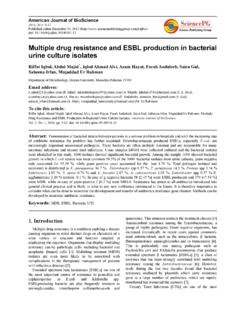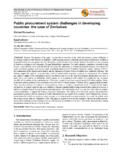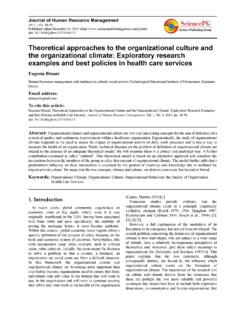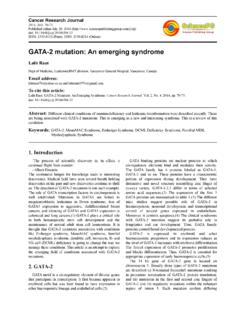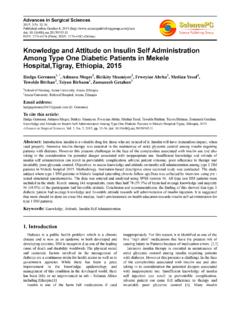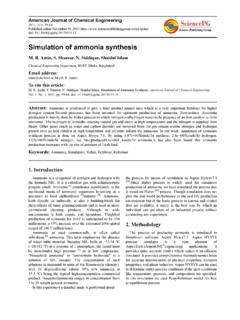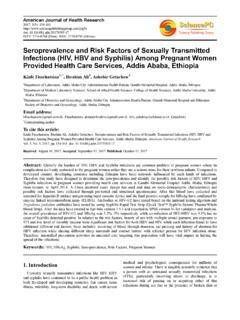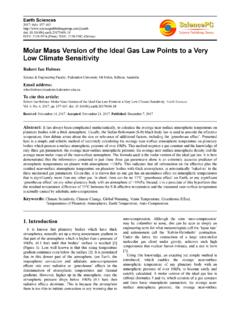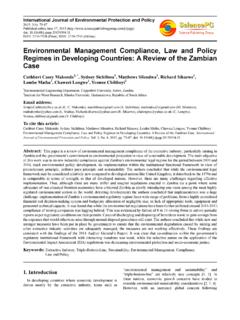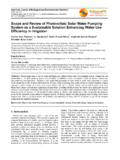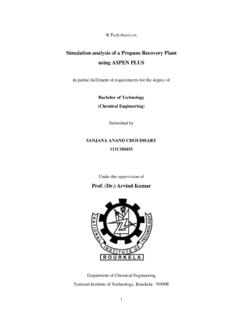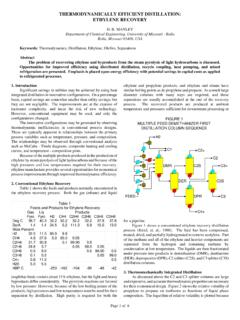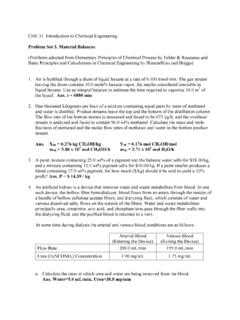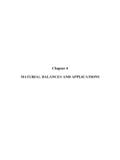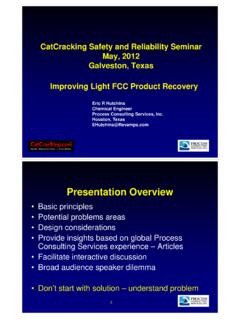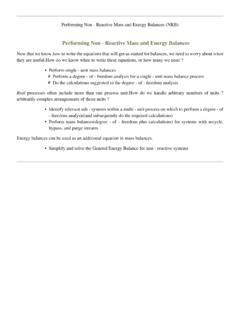Transcription of Comparative Economic Investigation Options for Liquefied ...
1 American Journal of Chemical Engineering 2015; 3(2-1): 55-69 Published online June 29, 2015 ( ) doi: ISSN: 2330-8605 (Print); ISSN: 2330-8613 (Online) Comparative Economic Investigation Options for Liquefied Petroleum Gas Production from Natural Gas Liquids A. B. Raheem1, 2, A. Hassan1, S. A. Samsudin1, Z. Z. Noor1, A. Adebobajo2 1 Faculty of Chemical Engineering, Universiti Teknologi Malaysia, Johor Bahru, Malaysia 2 Department of Chemical Engineering, University of Port Harcourt, Port Harcourt, Nigeria Email address: (A. B. Raheem) To cite this article: A. B. Raheem, A. Hassan, S. A. Samsudin, Z. Z. Noor, A. Adebobajo. Comparative Economic Investigation Options for Liquefied Petroleum Gas Production from Natural Gas Liquids. American Journal of Chemical Engineering. Special Issue: Developments in Petroleum Refining and Petrochemical Sector of the Oil and Gas Industry.
2 Vol. 3, No. 2-1, 2015, pp. 55-69. doi: Abstract: There is new trend in the value of oil and gas in the world, with the value of Liquefied Petroleum Gas (LPG) soaring higher. It is due to its uses as a potential fuel in the several parts of the world, its demand in the petrochemical industries for plastics and automotive composites productions, and other uses. These results in steadily increases in price. There is also increase in volume of feed gas, which demands efficient LPG processing and recovery technology. This paper mainly focuses on Comparative Economic Investigation Options for Liquefied Petroleum Gas plant, which processes feed from natural gas wells and dehydrating units to produce Liquefied Petroleum Gas along with natural gasoline having a higher value as separate product. Recovery of LPG is possible but raises both the initial cost of plant and operational cost considerably.
3 The value of LPG recovered should be high enough to widen the operating margins between the processing costs and the market price for which the recovered liquids can be sold. Therefore, the most Economic means of extracting this product must be used. This was done using two alternatives; the Conventional Fractionation process and single column overhead recycle process (SCORE). Both alternatives were simulated with Hysys and are analyzed based on product recovery level, energy required and fixed capital cost. There are two feeds to the plant, one from the natural gas wells and the other from dehydrating units of natural gas processing plants with a total flow rate of MMSCFD. Analysis of result from modeling shows that single column overhead recycle process has a total product recovery of % while Conventional fractionation process has a total recovery of %, the require energy margin between the alternatives is about % in favor of conventional process and the fixed capital cost is in the favor of single column process.
4 Sensitive to choosing the most Economic option of LPG recovery between the conventional process and SCORE process is the recovery level of LPG from each of the Options , total energy required and the cost of the equipment. From the analysis, it shows that, it is more economical to use the single column overhead recycle process, as compared to conventional fractionation process. Keywords: Liquefied Petroleum Gas Plant, Dehydrating Units, Conventional Fractionation Process, single Column overhead recycle Process, Hysys 1. Introduction Liquefied petroleum gas, also called LPG, GPL, LP Gas, liquid petroleum gas or simply propane, is a flammable mixture of hydrocarbon gases used as a fuel in heating appliances and vehicles. It is increasingly used as an aerosol propellant and a refrigerant, replacing chlorofluorocarbons in an effort to reduce damage to the ozone layer.
5 When specifically used as a vehicle fuel it is often referred to as auto gas [1, 2]. The purification of natural gas gotten from heavier hydrocarbon, in natural gas processing plants, require several stages of separation and fractionation. The separated liquid product obtains is named as natural gas liquids (NGL). The unrefined NGL is sent to LPG recovery plant to separate LPG that contains iso-propane (i-C3) and iso-butane (i-C4) from stabilized NGL (C5+) [3, 4]. The values and prices of both products are very high in the market due to their domestic and other usefulness s. Varieties of LPG bought and sold include mixes that are primarily propane (C3H8), primarily butane (C4H10) and, most commonly, mixes including both propane and butane, depending on the season in winter more propane, in summer more butane [1].
6 56 A. B. Raheem et al.: Comparative Economic Investigation Options for Liquefied Petroleum Gas Production from Natural Gas Liquids High demand of LPG as fuel in many parts of the World due to aforementioned uses, its availability (more gas wells) and price increase against the oil price makes it require more focus for more and effective production methods. In this work, LPG recovery plant is simulated using commercial software (Hysys) to investigate the process economy. The use of conventional fractionation process as an alternative to single column overhead recycle process (SCORE) is discussed in order to find the most Economic process for LPG production. 2. Properties of Liquefied Petroleum Gas It is an established fact that Liquefied Petroleum Gas (LPG) is a mixture of hydrocarbon gases, which consists mainly of propane and butane.
7 Its composition depends majorly on its source, processing principles and the season it is produced [5]. LPG processed in the winter always have record of containing more propane, whereas it contains more butane in the summer. At room temperature of say, 25o to 27 oC, propane vapor pressure is bar while butane vapor pressure is bar. LPG is normally odorless, colorless, non-toxic and ready to explode at a slight raised temperature. The peculiar distinctive pungent odour that it has is due to addition of odorizing agent such as ethanethiol, in other to reduce the danger of explosion that may arise due to undetected leaks from cargoes, pipes or tanks. LPG calorific value is 94 MJ/m (equivalents to kWh), which is higher than that of natural gas of 38 MJ/m (equivalents to kWh) [5]. The properties of LPG are tabulated in Table 1.
8 Table 1. Properties of LPG [6]. Name of the Property Value for LPG Freezing Point -187 OC Specific Gravity Vapour Pressure at 38 OC 1212 KPa Heat Content 50221 KJ / KG It is of interest to shows that recovery of LPG is possible but raises both the initial cost of plant and operational cost considerably. In order to achieve this, it is pertinent that the value of LPG recovered should be high enough to widen the operating margins between the processing costs and the market price for which the recovered liquids can be sold. Therefore, the most Economic means of extracting this product must be used. The utmost aim of this work is to investigating the Economic process of LPG production from NGL using two different alternatives. In order to help the already established and new industrial company have a realistic view of LPG recovery process and enhance their decisions as to making investment in this sector.
9 This research identifying an Economic or optima process of LPG recovery to encourage both already established and new industrial company from all over the world to invest in this sector, thus consumption of it will increase throughout the world as a result of its wide availability and most importantly, our environment will be protected because of its clean-burning property. Two alternative methods of extracting LPG from NGL were studied in this work and they are; single Column overhead recycle process (SCORE) and Conventional Fractionation Process. Both methods were modelled using the commercial process software (Hysys) and the results from modelling were compared. This method enabled the more Economic option stands out on its merit owing to the result of the modeling. The two major processes key operating measures, and benefits of the processes to investigate their recovery and economy efficiency performance of the LPG from NGL will be discussed further in the remaining part of this paper.
10 LPG Recovery Technology Several technologies have been developed in order to extract LPG from natural gas liquids (NGL). Also, researches coupled with simulations have been done to find the most optimum and Economic process. The recovery process can be categorized mainly into two groups namely; conventional and advance processes. Example of conventional fractionation process is shown in Figures 1, while examples of advance LPG recovery processes are shown in Figures 2, 3, 4, and 5. Conventional Fractionation Process There are four (4) columns used in this conventional process. First stage of LPG extraction from NGL is De-ethanizer. In this column, methane and ethane will be separated at the top of the column as vapour phase. The heavier hydrocarbons (C3+) flows at the bottom in liquid phase for next entering the Debutanizer column.
